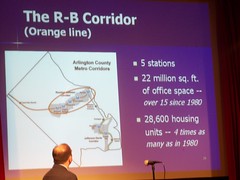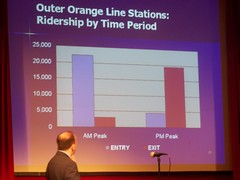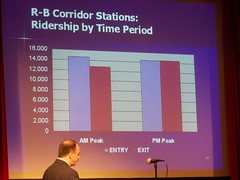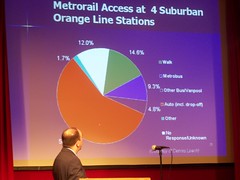Subway ridership on the Orange Line, Northern Virginia
A couple weeks ago, I went to a presentation on Smart Growth revisioning and repositioning of Rockville Pike in Montgomery County, in the area around White Flint. That area is a classic example of the "sprawl-suburban development" paradigm, based on automobility connectedness of separated uses
Although unlike a lot of sprawl, we wouldn't call this particular area deconcentrated. And it's a high income, high property value area, which sets the stage for the ability of the area to be redeveloped in a more concentrated, but also more walkable, fashion.
The change effort is being coordinated by a passel of developers, organized through a developers organization (eventually it could become something like a Business Improvement District, but much more development oriented) with a related "friends group" that they have created, the Friends of White Flint. Sure, their motivation is making more money, but that's capitalism and how great places can be made. As Alex Wall says in the book Victor Gruen: From Urban Shop to New City, "commerce is the engine of urbanism."
There were two presenters, Chris Zimmerman, an elected member of the Arlington County Board, who talked about Arlington County's planning and smart growth efforts, and Ian Lockwood of the planning firm Glatting Jackson (also home to Dan Burden of Walkable Communities fame, as well as David Barth, a leading parks planner), who spoke specifically about proposals to remake this section of Rockville Pike into a more balanced and walking-oriented environment.
The interesting thing to me is something I used to say when working with restauranteurs--to stay the same is to fall behind, because your best competitors are constantly improving, and your customers know this, because they are also shopping your competitors--in other words, to stay the same in DC is to fall behind, because the best places in the region will continue to improve.
Here are some slides on subway ridership, from Chris Zimmerman's portion of the presentation:
Arlington redefined itself through redevelopment along the Rosslyn-Ballston (Wilson Boulevard) corridor.

Ridership at the Outer Orange Line stations is unbalanced.

Ridership at the Rosslyn-Ballston corridor subway stations is balanced, a result of the mixed use land development paradigm.

How people get to the Rosslyn-Ballston subway stations -- they walk.

How people get to the Outer Orange Line subway stations -- they drive.

Labels: Growth Machine, smart growth, smart growth vs. smarter sprawl, sustainable land use and resource planning, transportation planning



0 Comments:
Post a Comment
<< Home